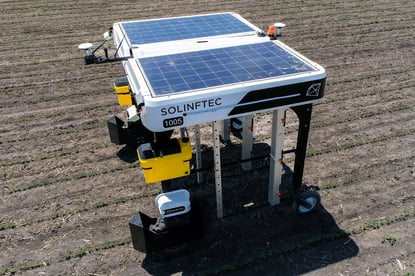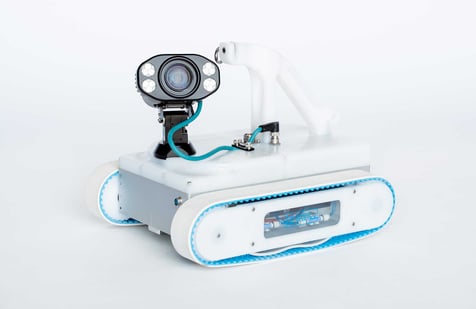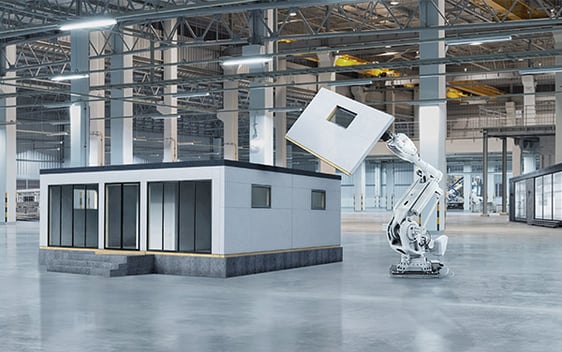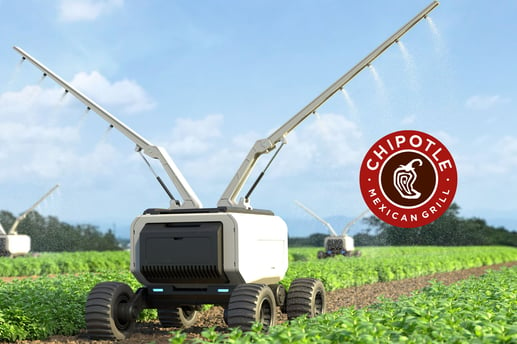What’s New in Robotics? 22.12.2023

Posted on Dec 22, 2023 7:30 AM. 9 min read time
News briefs for the week take a look at Christmas in Milton Keynes with Santa handing off gift deliveries to reindeer-painted robots, then to the first robot factory ever for rural Indiana’s farmers, then to preventing failures and explosions within industrial storage tanks using wall-climbing robots, to ABB creating a much-needed factory-built homebuilding industry in partnership with Porsche, and then to Chipotle adding “climate-smart fertilizer” to its menu.
Santa comes to town as a mobile reindeer robot
 If the Ghost of Christmas Past ever appears in downtown Milton Keynes, UK, he’ll undoubtedly break into a broad smile upon seeing Santa’s Christmas gifts delivered by autonomous vehicles. Tradition lives on in mobile robots, painted like reindeer!
If the Ghost of Christmas Past ever appears in downtown Milton Keynes, UK, he’ll undoubtedly break into a broad smile upon seeing Santa’s Christmas gifts delivered by autonomous vehicles. Tradition lives on in mobile robots, painted like reindeer!
Fifty miles northwest of London, about 100 of San Francisco-based Starship Technologies’ autonomous vehicles, deliver most anything in town. Decorated like reindeer, a Starship’s 10kg trunk space is perfect for delivering Christmas presents to friends and family. In addition to the cost of a nicely wrapped present, delivery charges (depending on the distance) start at 99 pence ($1.20).
Founded in 2014, Starship has taken autonomous delivery from future concept to a daily part of life. We believe robots are vital in solving last-mile delivery challenges, say founders Ahti Heinla and Janus Friis.
 The pair claim that Starship delivery robots have completed over 5 million autonomous deliveries worldwide—the first and only robot delivery company to do so!
The pair claim that Starship delivery robots have completed over 5 million autonomous deliveries worldwide—the first and only robot delivery company to do so!
Milton Keynes, a new town of about 300k residents, with its wide paths and cycleways for bots to drive, is ideal for Starship robots. In a recent Economist article, Delivery Robots Will Transform Christmas, residents admit that they hardly notice the bots a few months after deliveries began.
“That’s when you know a new technology is successful,” says Ed Lovelock, product manager for Starship. “People don’t notice it any longer.”
The robots navigate along pre-mapped routes using satellite positioning. Sensors, including a dozen cameras and radar, create a “bubble of awareness” around the robot. On arrival, customers use their phone to unlock the robot’s storage compartment and collect their shopping. And if anyone tries to steal them or their contents, the bots emit a high-pitched shriek.
Rural Indiana’s First Robot Factory
Although world-famous Purdue University and its esteemed research labs are in the same town, not much else goes on in West Lafayette, Indiana, except the slow meander of the Wabash River and a whole lot of crops growing seemingly everywhere.
All of which is precisely why the Wabash Heartland Innovation Network (WHIN) worked so hard to get a robot factory built in this part of rural Indiana. As the WHIN website tells it: WHIN is a consortium of 10 counties in north-central Indiana devoted to working together “to fuel prosperity by harnessing the power of Internet-enabled sensors to develop our region into a global epicenter of digital agriculture and next-generation manufacturing.”
 Johnny Park, WHIN’s CEO, and his team pulled off both digital agriculture and next-gen manufacturing. Brazil-based Solix Ag Robotics, in conjunction with WHIN, is building a robot factory, which will be the Midwest's first factory dedicated to agricultural robotics, right in the heart of where farmers could make use of robot-driven automation.
Johnny Park, WHIN’s CEO, and his team pulled off both digital agriculture and next-gen manufacturing. Brazil-based Solix Ag Robotics, in conjunction with WHIN, is building a robot factory, which will be the Midwest's first factory dedicated to agricultural robotics, right in the heart of where farmers could make use of robot-driven automation.
A leader in artificial intelligence solutions and sustainable agriculture practices, Solix AG Robotics showcased its latest technology platform at this year’s Farm Progress Show in Decatur, Illinois. Specifically, the Sprayer robot was on display. The Solix Sprayer is able to make precise applications of herbicides, which allows for extremely efficient weed control. Solix claims a near 95% saving in the use of herbicides. With some herbicides costing $20 to $40-plus per gallon, herbicides for weed control represent 60% of the volume and 65% of the expenditures for pesticides used by U.S. farmers.
“The Solix Sprayer is powered by four solar panels that control its drive system and spraying system, providing reports on crop populations, weed identification and densities, insect identification, spraying maps with analysis of inputs, and other data layers for producer analysis 24 hours a day, 7 days a week.
The Solix Sprayer can cover up to 50 acres per day, depending on the field's shape and terrain.” The Solix factory in West Lafayette will produce 20 Solix robots per day, and there’s already a waiting list for orders.
Wall-climbing robots prevent disasters in storage tanks
In many respects, large, industrial storage tanks are like warehouses but for liquids and gases. Liquids and gasses flow into the tanks, and then exit as quickly as possible, bound for customers all over the U.S. and abroad. The U.S. has over 3 million such storage tanks.
 The problem with these types of warehouses is that both the exterior and interior walls, as well as the tanks’ pipe networks, need constant surveillance and preventive maintenance to avoid explosions like the 2021 multi-tank explosion of #6 heating fuel in Ennis, TX.
The problem with these types of warehouses is that both the exterior and interior walls, as well as the tanks’ pipe networks, need constant surveillance and preventive maintenance to avoid explosions like the 2021 multi-tank explosion of #6 heating fuel in Ennis, TX.
Invert Robotics provides non-destructive inspection services using tracked, mobile climbing robots (see video)
The Invert robot’s on-board camera can inspect the inside of the tanks for cracks, bad seals, or improper cleaning. Spotting such defects early on can help prevent industrial accidents like tank failures and explosions.
Invert says that by using wall-crawling robots inspections are far more precise and faster than manual inspections. There’s no staging of scaffolding necessary or rope harnesses or ladders required as with manual inspections. “Invert’s robot just sticks to the wall,” says the company about its proprietary magnetic adhesion system; and because it is so small, it can navigate into smaller spaces than a human would typically fit.”
Investors seem to believe in the Invert mobile robot; another $2.8 million was just added December 3 to the company’s money stash that now tops $25 million.
ABB’s robots to build homes
Applications for robots are near-limitless, and Swiss-based ABB Robotics thinks it has found yet another one that not only fulfills a growing social need but can also make billions of dollars: Housing, residential housing. Specifically, using robots to build modular homes in a factory. It’s certainly not a novel idea; factory-built homes are everywhere, but not in quantity.
Seems ABB Robotics agrees with a recent New York Times article sporting the to-the-point headline: Why Do We Build Houses in the Same Way That We Did 125 Years Ago?
Actually, ABB had its own research done on the very same subject, concluding from its global survey: “Of 1,900 large and small construction businesses in Europe, the U.S. and China, only 55% of construction companies say they use robots, compared with 84% in automotive and 79% in general manufacturing.
 “The survey also shows 81% of construction businesses plan to introduce or increase the use of robotics and automation in the next decade.”
“The survey also shows 81% of construction businesses plan to introduce or increase the use of robotics and automation in the next decade.”
Entering into a new business venture, ABB Robotics and Porsche Consulting have announced a collaboration to drive automation in the construction industry with a pilot project to develop new practices in modular housing manufacturing.
“The companies say this collaboration will help meet the need for more affordable and sustainable buildings and reduce the environmental impact of construction.”
Marc Segura, president of the ABB Robotics Division is high on the plan. “We think there is a clear opportunity to transform this sector and the way homes are built by automating the process of manufacturing modular components.”
ABB Robotics and Porsche feel that the missing ingredient to more factory-built homes is the addition of more intelligent automation that will offset widespread construction labor shortages and that the ABB/Porsche collaboration will boost productivity, “allow greater customization and enable more sustainable and efficient construction practices.”
Chipotle’s new menu item: climate-smart fertilizer
Food retailer and restaurant-chain giant Chipotle has a new robot buddy, and it doesn’t work in the kitchen or serve food. It’s a farm robot in which Chipotle has just invested $50 million.
 “Chipotle Mexican Grill says it has invested in Greenfield Robotics, a company leveraging artificial intelligence, robotics and sensing technologies, and Nitricity, a company producing fertilizer without carbon emissions.”
“Chipotle Mexican Grill says it has invested in Greenfield Robotics, a company leveraging artificial intelligence, robotics and sensing technologies, and Nitricity, a company producing fertilizer without carbon emissions.”
Curt Garner, chief customer and technology officer for Chipotle, said in a release. "We will help Greenfield Robotics scale their robotic offerings and explore how their robots can be deployed on farms within our supply chain."
Basically, the plan is to convert Greenfield’s current robots that cut weeds between rows of crops, and to use the investment to expand and enhance weed control with additional autonomous solutions for micro-spraying, cover-crop planting and soil testing.
The other party, Nitricity, uses artificial lightning to create a more sustainable and cost-efficient fertilizer, which, according to the Chipotle PR release, “Nitricity's nitrogen fertilizer has five to 10 times less greenhouse gas emissions.”
Field trials of Nitricity’s fertilizer have begun with select farmers in Salinas Valley and also with some of Chipotle’s farm suppliers. The company said the investment from Chipotle will help build out infrastructure and support the launch of its first commercial product.


Leave a comment